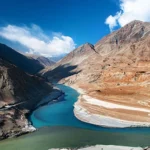
The Yellow River, known as Huang He in Chinese, is not just one of the longest rivers in the world; it is also a vital artery of life, culture, and history in China. Flowing over 5,400 kilometers through diverse landscapes, this river has shaped the lives of countless generations, providing water, fertile soil, and a rich tapestry of cultural heritage. From its ancient flood control techniques to its pivotal role in agriculture and industry, the Yellow River is a fascinating subject of study. In this blog, we will explore 25 intriguing facts about the Yellow River that highlight its significance, challenges, and the enduring relationship between this remarkable waterway and the people who depend on it. Whether you’re a history buff, a nature enthusiast, or simply curious about this iconic river, these facts will deepen your appreciation for the Yellow River and its impact on civilization.
Length: The Yellow River, known as the Huang He in Mandarin, stretches approximately 5,464 kilometers (3,395 miles), making it the second-longest river in China, following the Yangtze River. Its course traverses nine provinces, including Qinghai, Sichuan, Gansu, Ningxia, Inner Mongolia, Shaanxi, Shanxi, Henan, and Shandong. The river’s length is significant not only for its geographical span but also for the diverse ecosystems and cultures it supports along its banks. The river’s extensive journey from the Bayan Har Mountains to the Bohai Sea showcases the varying landscapes of China, from high plateaus to fertile plains.
Basin Area: The Yellow River basin encompasses an area of approximately 752,000 square kilometers (290,000 square miles), which is about 7.8% of China’s total land area. This vast basin is characterized by a variety of landscapes, including mountains, plateaus, and plains, and it plays a crucial role in China’s agriculture, economy, and history. The basin is often referred to as the “cradle of Chinese civilization” because it has been the birthplace of many dynasties and cultural developments. The fertile land around the river supports extensive farming, particularly of staple crops like wheat and millet.
Source: The Yellow River originates from the Bayan Har Mountains in Qinghai province, at an elevation of around 4,500 meters (14,800 feet). This mountainous region is known for its unique biodiversity and is part of the Tibetan Plateau. The river begins as a small stream, fed by melting snow and glaciers, and gradually grows as it collects water from various tributaries. The source area is significant for its ecological importance, as it is home to various wildlife and serves as a critical water source for downstream regions, providing essential resources for millions of people.
Mouth Location: The Yellow River empties into the Bohai Sea, located near the city of Dongying in Shandong province. The river’s delta is one of the most productive agricultural regions in China, where the sediment carried by the river contributes to the fertility of the soil. The mouth of the river has historically been a vital area for trade and transportation, facilitating economic activities and cultural exchanges. However, the delta is also vulnerable to environmental issues such as pollution and land subsidence, which pose challenges to its sustainability.
Sediment Load: The Yellow River is renowned for its high sediment load, averaging about 1.6 billion tons per year. This sediment, primarily composed of silt and clay, is a result of erosion from the river’s upper reaches and contributes to the river’s distinctive yellow coloration. The sedimentation process is a double-edged sword; while it enriches agricultural land in the delta, it also leads to challenges such as increased flooding risk and navigation difficulties. The river’s sediment transport is a crucial aspect of its hydrology and has significant implications for flood management and land use.
Depth: The average depth of the Yellow River varies significantly along its course, with some sections reaching depths of up to 40 meters (131 feet). This variation in depth affects the river’s flow dynamics, sediment transport, and the ecosystems that depend on it. In shallower areas, the river may be more prone to sediment deposition, while deeper sections can facilitate navigation and support various aquatic life. Understanding the depth and flow characteristics of the river is essential for effective water management, flood control, and ecological conservation.
Discharge: The average discharge of the Yellow River is approximately 2,570 cubic meters per second (90,800 cubic feet per second). This measurement reflects the volume of water flowing through the river at any given time and is influenced by seasonal variations, rainfall patterns, and upstream water usage. Discharge levels are critical for determining water availability for irrigation, drinking, and industrial use. The river’s discharge has fluctuated over the years due to climate change and human activities, leading to concerns about water scarcity and management in the basin.
Flooding History: The Yellow River is infamous for its catastrophic floods, with the most devastating event occurring in 1931. This flood is estimated to have caused between 1 million to 4 million deaths, making it one of the deadliest natural disasters in history. The river’s propensity for flooding is attributed to its high sediment load, which raises the riverbed and increases the risk of overflow during heavy rains. Historical records indicate that major floods have occurred frequently over the centuries, leading to significant changes in settlement patterns, agricultural practices, and water management strategies in the region.
Historical Importance: The Yellow River holds immense historical significance as it is often referred to as the “cradle of Chinese civilization.” This title reflects the river’s role in supporting early agricultural societies, which emerged around 6,000 years ago. The fertile plains along the river allowed for the cultivation of staple crops such as millet and wheat, fostering the growth of settled communities and the development of complex societies. Throughout history, the river has been central to the rise and fall of various dynasties, serving as a vital transportation route and cultural artery. It has also been a source of inspiration in Chinese literature, art, and philosophy, symbolizing both the nurturing and destructive forces of nature.
Tributaries: The Yellow River has more than 30 major tributaries that contribute to its flow, with the Luo River being one of the most significant. These tributaries vary greatly in size and influence, with some originating from mountainous regions and others flowing through plains. The tributaries play a crucial role in the hydrology of the Yellow River, affecting its water levels, sediment transport, and ecological health. The interaction between the main river and its tributaries creates diverse habitats that support a variety of wildlife and plant species. Additionally, the management of these tributaries is essential for flood control, irrigation, and maintaining water quality in the Yellow River system.
Water Quality: Recent assessments indicate that about 50% of the Yellow River’s water is polluted and unfit for drinking. This pollution primarily stems from industrial discharges, agricultural runoff, and untreated sewage. The river’s water quality has deteriorated over the years due to rapid industrialization and urbanization in the surrounding regions. Efforts are underway to improve water quality through stricter regulations on waste discharge and initiatives aimed at reducing agricultural runoff, but challenges remain in restoring the river’s health and ensuring safe water for the millions of people who rely on it.
Irrigation: The Yellow River basin supports the irrigation of approximately 1.6 million hectares (about 4 million acres) of farmland. This extensive irrigation network is vital for agricultural production in one of China’s most important farming regions. The river provides essential water resources for crops such as wheat, corn, and rice, which are staples of the Chinese diet. Effective irrigation management is crucial to maximizing crop yields, especially in light of periodic droughts and water scarcity issues. Farmers in the region have historically relied on the river for irrigation, making it integral to food security and the local economy.
Dikes and Levees: Over 3,000 kilometers (1,864 miles) of dikes and levees have been constructed along the Yellow River to manage flooding and protect surrounding communities. These structures help contain the river’s flow during periods of high water, reducing the risk of inundation in populated areas. However, the reliance on dikes and levees can create a false sense of security, as they can fail under extreme conditions. The management of these flood control systems is critical, requiring ongoing maintenance and upgrades to adapt to changing environmental conditions and to mitigate the impacts of climate change.
Economic Importance: The Yellow River basin is home to around 110 million people, making it one of the most densely populated river basins in the world. This concentration of population has significant economic implications, as the river supports various industries, agriculture, and transportation. The economic activities in the basin include farming, fishing, and manufacturing, all of which are closely tied to the river’s resources. The river also serves as a critical transportation route, facilitating trade and commerce between regions. However, the high population density also places immense pressure on the river’s water resources and ecological health.
Cultural Significance: The Yellow River has been a central theme in Chinese literature, art, and folklore for thousands of years. It is often depicted as a powerful symbol of life, resilience, and the duality of nature, representing both nourishment and destruction. Many famous poems and historical texts reference the river, highlighting its importance in shaping Chinese identity and culture. Festivals and cultural events celebrate the river’s significance, reinforcing its role as a national symbol. This cultural heritage underscores the deep connection between the Chinese people and the Yellow River, which continues to influence contemporary society.
Wildlife: The Yellow River is home to several endangered species, including the Yangtze giant softshell turtle, which is one of the rarest turtles in the world. The river’s diverse ecosystems support a variety of aquatic and terrestrial wildlife, but habitat degradation, pollution, and overfishing pose significant threats to these species. Conservation efforts are being implemented to protect the river’s biodiversity, including habitat restoration and breeding programs for endangered species. The health of the river’s ecosystems is crucial not only for wildlife but also for maintaining the overall environmental balance in the region.
Historical Records: The earliest recorded flood of the Yellow River dates back to 602 BC, documented in historical texts such as the “Book of Documents.” This long history of flooding has shaped the river’s management and the development of flood control strategies in China. These records provide valuable insights into the river’s behavior, the impacts of natural disasters on society, and the evolution of human adaptation to the river’s challenges. The historical context of flooding has influenced agricultural practices, settlement patterns, and governmental policies throughout Chinese history.
Hydroelectric Power: The Yellow River has several dams, including the Sanmenxia Dam, which has a capacity of 1,000 megawatts (MW). These hydroelectric facilities play a crucial role in generating renewable energy and managing water resources. The dams help regulate river flow, provide flood control, and support irrigation needs. However, the construction of dams also raises concerns about ecological impacts, including alterations to fish migration patterns and changes in sediment transport. Balancing energy production with environmental conservation is an ongoing challenge in managing the river’s resources.
Pollution Sources: The Yellow River, known as Huang He in Chinese, faces significant pollution challenges. Major sources of this pollution include industrial discharge from factories along its banks, agricultural runoff containing fertilizers and pesticides, and untreated sewage from urban areas. These pollutants not only degrade water quality but also pose serious health risks to the communities relying on the river for drinking water and irrigation. The impact of pollution has led to increased efforts in monitoring and regulating discharges, but challenges remain due to rapid industrial growth and urbanization in the region.
Water Management: The Yellow River Conservancy Commission was established in 1946 as an essential body for overseeing the management and conservation of the river. This organization is tasked with addressing the multifaceted challenges associated with the river, including flood control, water allocation, and environmental protection. The commission plays a crucial role in coordinating efforts among various provinces and stakeholders to ensure sustainable use of the river’s resources. Its work is vital, given the river’s historical significance and its role in supporting agriculture and livelihoods for millions of people.
Climate Impact: Climate change has significantly affected the flow of the Yellow River, which is evident in the altered precipitation patterns within its basin. These changes can lead to severe droughts in some areas and increased flooding in others, disrupting the delicate balance of the ecosystem and the livelihoods of those who depend on the river. The variability in water flow also complicates water management strategies, making it imperative for authorities to adapt to these climate-related challenges. Understanding these impacts is crucial for developing effective policies to safeguard the river’s future.
Historical Flood Control: The historical significance of the Yellow River is underscored by the ancient Chinese civilization’s development of flood control techniques as early as 2200 BC. These early methods included the construction of levees and canals designed to manage the river’s flow and mitigate flooding risks. Such engineering feats reflect the ingenuity of ancient societies in responding to the challenges posed by the river’s unpredictable nature. Over the centuries, these flood control measures have evolved, but the foundational principles established by early civilizations continue to inform modern practices in managing the river.
Geological Feature: The Yellow River is renowned for its high silt content, which contributes to its distinctive yellow color. This silt, primarily composed of loess soil, is carried downstream by the river and plays a crucial role in enriching the floodplain, making it one of the most fertile agricultural regions in China. However, the river’s sediment load also poses challenges, as excessive siltation can lead to increased flooding and the need for ongoing dredging and management efforts. The unique geological characteristics of the river are a testament to its dynamic nature and the interplay between natural processes and human activities.
Cultural Festivals: The cultural significance of the Yellow River is celebrated through various festivals, such as the Yellow River Culture Festival. This event highlights the historical and cultural importance of the river to the Chinese people, showcasing traditional music, dance, and art that reflect the river’s role in shaping the region’s identity. The festival serves as a reminder of the river’s vital contributions to agriculture, trade, and civilization throughout history, fostering a sense of community and pride among those who live along its banks.
Biodiversity: The Yellow River supports a diverse ecosystem that includes various fish species, birds, and other wildlife. However, habitat degradation due to pollution, overfishing, and land development has threatened many of these species over the years. Conservation efforts are increasingly important to protect the river’s biodiversity and restore habitats that have been compromised. Initiatives aimed at promoting sustainable practices and raising awareness about the importance of preserving the river’s ecosystem are essential to ensure that future generations can continue to benefit from its natural resources.
Frequently Asked Questions about the Yellow River:
1. What is the Yellow River and where is it located?
The Yellow River, known as Huang He in Mandarin, is the second-longest river in China, flowing approximately 5,464 kilometers (3,395 miles) through nine provinces before emptying into the Bohai Sea. It originates from the Bayan Har Mountains in Qinghai province and travels through significant regions, including Shanxi, Shaanxi, and Henan, before reaching its delta in Shandong province. The river is often referred to as the “cradle of Chinese civilization” due to its historical importance in supporting agriculture and settlements.
2. Why is the Yellow River called “Yellow”?
The Yellow River gets its name from the high silt content in its waters, which gives it a distinctive yellowish-brown color. This silt, primarily composed of loess soil, is carried downstream from the river’s source and contributes to the fertile plains along its banks. The river’s sediment load has played a crucial role in the agriculture of northern China, making the surrounding land some of the most productive in the country.
3. What are the major environmental issues facing the Yellow River?
The Yellow River faces several environmental challenges, including pollution from industrial discharge, agricultural runoff, and untreated sewage. Additionally, over-extraction of water for irrigation and urban use has led to reduced flow and increased salinity in some areas. Climate change has also impacted the river’s flow patterns, leading to droughts and flooding. These issues threaten the ecosystem and the livelihoods of millions who depend on the river for water and agriculture.
4. What historical significance does the Yellow River hold?
Historically, the Yellow River is often referred to as the “mother river” of China, as it has been central to the development of Chinese civilization for thousands of years. It supported early agricultural communities and was crucial for trade and transportation. The river has also been the site of numerous historical events, including battles and floods, which have shaped the culture and governance of the region. Ancient Chinese civilizations developed sophisticated flood control techniques, such as levees and canals, to manage the river’s unpredictable nature.
5. How does the Yellow River impact agriculture in China?
The Yellow River is vital for agriculture in northern China, providing irrigation to vast areas of farmland. The fertile silt carried by the river enriches the soil, making it ideal for growing staple crops such as wheat, millet, and corn. However, the river’s water management is critical, as overuse and pollution can lead to decreased agricultural productivity. Efforts to improve water conservation and sustainable farming practices are essential to maintain the agricultural benefits of the river.
6. What are some cultural aspects associated with the Yellow River?
The Yellow River is deeply embedded in Chinese culture and folklore, symbolizing life, sustenance, and resilience. It is celebrated in various festivals, such as the Yellow River Culture Festival, which showcases traditional music, dance, and art that reflect its historical significance. The river has also inspired countless poems, paintings, and stories throughout Chinese history, highlighting its role as a source of inspiration and pride for the people living along its banks.
7. What measures are being taken to protect and restore the Yellow River?
Efforts to protect and restore the Yellow River include government initiatives aimed at reducing pollution, improving water management, and promoting sustainable agricultural practices. Programs have been implemented to monitor water quality and regulate industrial discharges. Additionally, conservation projects focus on restoring habitats and promoting biodiversity in the river ecosystem. Public awareness campaigns are also crucial in encouraging communities to engage in sustainable practices and protect this vital waterway.
8. What are the major tributaries of the Yellow River?
The Yellow River has several major tributaries that contribute to its flow, including the Luo, Fen, Luohe, and Tao rivers. These tributaries play a significant role in draining water from their respective catchment areas and enhancing the overall water supply of the Yellow River. Understanding the tributaries is essential for effective water management and conservation efforts, as they collectively impact the river’s health and sustainability.
9. How does climate change affect the Yellow River?
Climate change significantly impacts the Yellow River by altering precipitation patterns, leading to increased variability in water flow. Some areas experience prolonged droughts, while others face severe flooding. These changes complicate water management strategies and pose risks to agriculture, ecosystems, and communities that depend on the river. Adapting to these climate-related challenges is crucial for ensuring the river’s health and the livelihoods of those who rely on it.
10. Can you visit the Yellow River, and what are some popular tourist attractions?
Yes, the Yellow River is a popular tourist destination, offering various attractions that highlight its natural beauty and cultural significance. Some popular tourist spots along the river include:
- Yellow River Scenic Area in Zhengzhou: This area features stunning views of the river, parks, and recreational facilities. Visitors can enjoy boat rides, walking trails, and exhibitions that showcase the river’s history and importance.
- The Hukou Waterfall: Located at the junction of Shanxi and Shaanxi provinces, Hukou Waterfall is the largest waterfall on the Yellow River and a breathtaking natural spectacle. The waterfall is especially impressive during the rainy season when the river’s flow increases.
- The Yellow River Museum in Zhengzhou: This museum offers insights into the history, culture, and ecology of the Yellow River. It features exhibits on the river’s role in Chinese civilization, flood control efforts, and the challenges it faces today.
- The Loess Plateau: This region, known for its unique geological features and rich cultural heritage, is located upstream of the Yellow River. Visitors can explore traditional villages, experience local customs, and learn about the historical significance of the area.
- The Yellow River Culture Festival: Held annually, this festival celebrates the cultural heritage associated with the Yellow River through performances, art exhibitions, and traditional activities. It attracts both locals and tourists, fostering a sense of community and appreciation for the river’s legacy.
Visiting the Yellow River offers a unique opportunity to connect with China’s history, culture, and natural beauty, making it a worthwhile destination for travelers interested in exploring this iconic waterway.









